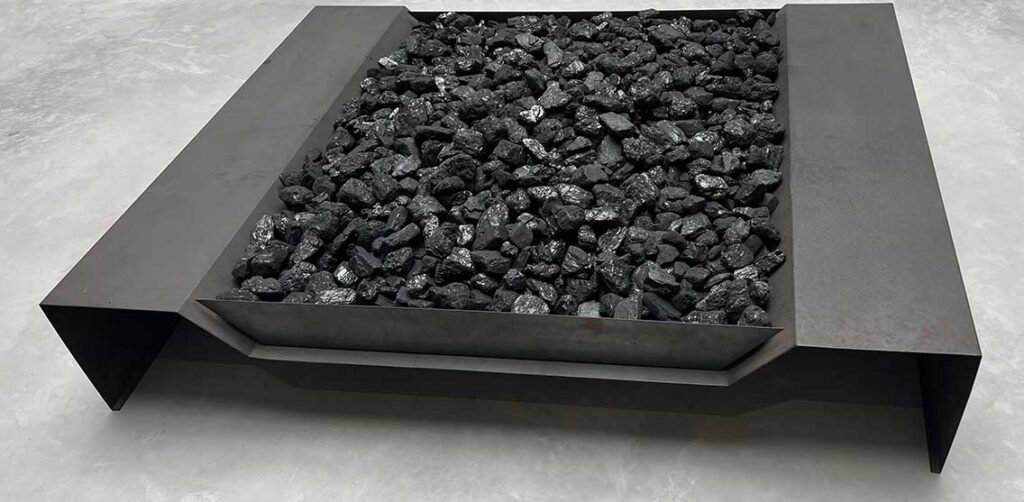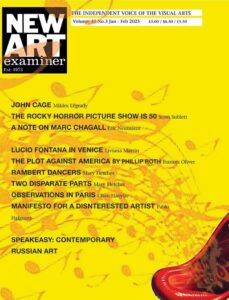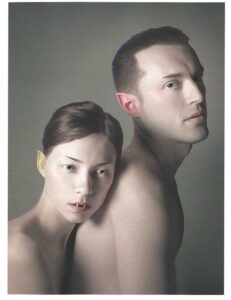Nancy Nesvet
Arte Povera, (Poor Art), an Italian movement championing new experiments in visual art, music, literature, installation and performance, was first announced to the public via a manifesto entitled, Notes on a Guerilla War by Germano Celant, first published in Flash Art’s, November-December 1967 issue. Arte Povera is most often cited as a movement that relied on the use of ‘poor materials’, meaning pre-industrial, non-technological means for making art, but also identified the poor, Povera, according to their actions and behaviors: the rich, according to Celant, work within the system whereas the poor do not, seeking an alternative, often an abolition of all positions. With Arte Povera relying on individuals, as Celant proclaimed, “man is the message”, a community of those practicing Arte Povera questioned reality and the behavior of capitalist society as perceived visually and explored psychological interpretations questioning reality as made by those in power, newly interpreting their world.

This 1960’s and 70’s Italian communal art movement reacted to the situation in Italy after the Second World War. They illustrated positive applications of discoveries in physics and chemistry before the war while questioning the increasing role of technology and mechanization, arguing for the use of pre-industrial revolution materials. The exhibition, Arte Povera, produced by the Pinault Collection, at the Bourse de Commerce in Paris, an odd venue for a movement that railed against commercialization, but one that illustrates Arte Povera’s often satirical methods, assembled a comprehensive exhibition of work produced by artists associated with Arte Povera, their influences and those they continue to influence today.
It was a time of experimentation, using materials available in a country deeply affected by the recent war, teaching artists to use what they could find, to make art elevating common material to make artistic statements, to make art of the people, rather than the economically well off and celebrated. Exhibiting the first installation of contemporary art, the Arte Povera artists showed humans, animals, minerals and vegetables in co-evolution, rising from the floor- based horizontal stature of animals, the ground- home of vegetable and mineral to the later vertical stance of humans and the attendant verticality of paintings. The materials chosen most often included natural materials, plants, minerals, dirt, and the detritus of civilization, rags, oil, and smoke. Demonstrations and installations illustrated and explored forms of energy, including oil production and transmission of electricity and power.
On the museum’s façade, beginning near the right entrance, Mario Merz’s Numero di Fibonacci weaves around the building’s back, as we encounter neon numbers representing the numbers of the Fibonacci sequence where each number is equal to the preceding two, much like couples producing children, but also illustrating the creative act whose progeny doubles. Realizing that electricity producing light in a neon tube is likened to electricity produced by lightning bolts, he brings science together with art, natural phenomena with man-made installation.

First encountered inside, against the walls of the circular space, is Senza Titulo (Materassi) (Untitled) (Mattresses), the 1970 work first shown at the Sonnabend Gallery in Paris shows six mattresses, standing upright as they were at the Jeu de Paume in 1994. Lighted tubes connecting the mattresses become abstract scrawls, recalling the shapes of paintings but softer, and connected. Differing from the original intention afforded by the horizontal to the floor staging of the work, it more resembles a typical museum installation than one to be walked on or around, but establishes the verticality of a painted canvas, making the mattress not a soft place on which to lie, but an art object.

Overall, the exhibition intentionally recalls the Arte Povera installation on the floor at Deposito d’Arte Presento at Turin in the late 1960’s. Here, at the Bourse de Commerce as in Turin, art was largely installed horizontally, on the floor, denying its existence as painting or sculpture, but rather, to be encountered, touched, a field to be walked upon or what Luciano Fabro, whose work, Lo Spirato is exhibited here, called a habitat, a place to be lived in. The 2003 Arte Povera show at the Hirschhorn Museum in Washington, DC, also exhibited horizontally, on the floor, was made largely of living plants and other commonly encountered natural materials. Giuseppe Penone’s Idea di Pietra-1532 kg di luce (kilograms of light), a bronze cast tree holds river rocks in the interspaces where branches intersect, interpreted as stable rocks with living, meandering branches weaving around them, like thought processes around the stable mind.

Further on, Mario Merz’s lifelong companion, Marisa Merz’s Senza Titolo’s delicate rhythmic sounds of water flowing in a fountain rise above a wax violin in a lead basin on the ground providing opposites; malleable wax surrounded by formed, hard impenetrable lead, as a magnet attracting the metal spout, shapes the water into the form of a heart. The force of magnetism urges lead to bend into a shape interpreting love, recalling the biblical admonition to turn weapons into plowshares.
In the vitrines surrounding the circular passageway, writings, books, artwork, posters photographs and historical documents tell the story of the movement. Multiples, new media, documents of collective performances and experimental theatre are included. Past influences are documented as is the work influenced by Arte Povera including that of David Hammons, Theaster Gates, D Harding and Otobong Nkanga, all illustrating the collective and cooperative nature of those involved in Arte Povera.
Fabio Mauri’s Screens mimic the rectangular shapes of movie or television screens but also military insignia and license plates, exploring the connections between power and media. The exhibition includes Mauri’s many cultural practices including theatre, performance, writing, publishing and film installation, noting the founding of the magazine Citta di Riga with Kounellis, but also his projection of Pasolini’s film, Vangelo secondo Matteo (The Gospel according to Saint Matthew) projected onto Passolini’s white clad body. Noting the inspiration for future projection work, we might look to Krzyszko Wodjczko’s later projections onto a statue of Abraham Lincoln and his projection of Ronald Reagan’s hand posed in honor of the pledge of allegiance standing in for corporate business.
Three works at eye level; Jannis Kousellis’ 1969 work created for Live in Your Head, at the Kunsthalle Basel, rejected by Customs as an artwork, deemed instead commercial goods opened a new investigation for Kousellis, who then created an artwork evoking the transportation of commercial goods. To note this forerunner of the Andy Warhol’s pop art magnification of Brillo boxes and Campbell’s soup cans is obvious. When Attitude Becomes Form Giulio Paolini’s 1967 Lo Spazio made up of eight letters composing words, foreruns later text work of Barbara Kruger and Jasper Johns. Emilio Prini’s five packets of lead defining space led to the confusion of space in Pier Paolo Calzolari’s 1967 icing structure, Senzo Titolo (Untitled) and the steam produced by Alighiro Boetti’s 1993-4 Autoritratto. That steam also recalls the production of the steam locomotive, linked with the onset of the industrial revolution as well as, chillingly, the steam produced by trains carrying people to gas chambers during the Nazi era. Giovanni Anselmo’s Direzione where a boxed needle points north, orienting us, illustrates attempts of Arte Povera artists to encounter, define, illustrate space and people’s place in it and to redefine and make known the possibilities of space and materiality, but interestingly, in pointing north, aims at Paris where we are.

With Mario Merz’s igloos in the exhibition recalling nomadic societies and their dwellings, through which one can see the sky, we recall Hausmann’s attempt to design Paris’ space, due north of Italy, as one to circumambulate, including art above and on the ground, as navigational markers, whether the high ground of Montmartre, the markers on sidewalks, bridges that cross the Seine, or Notre Dame herself, from which Quasimodo supposedly looked down at the ground to see Esmerelda dance in the square of the people.
This is art after World War II, when cities were blown away, burned to smoking piles of residue, people displaced and stripped of any belongings they had. Here, the smoke is seen, the land horizontal and bare but for nature coming back, piles of clothes, rags, in Michelangelo Pistoletti’s installation, Venere degli stracci piled high; with no longer use to those who wore them. Yet there is optimism and curiosity. His exploration of mirrors to effect transformation, part of his practice since 1962 wherein the pictorial surface becomes a passage into a different world becoming the caged sphere. Mappamonda, recalls his sphere of newspapers rolled through the city by a cooperative group of artists, gathering dirt from the street.
The art on the second floor veers away from investigation of materials and orientations to explorations of production of energy. Gilberto Zorio’s work shows an electric current running through a chrome nickel wire, showing the use of materials to create new forms of energy. For me, the allusion to Einstein’s work cannot be avoided, as these artists attempt, as he did, to better the world by bringing new forms and adaptations of creating energy. Nor can we avoid noting that although man misused Einstein’s discoveries to destroy, here Arte Povera artists create but also question new forms that might or might not benefit the populace. Genovese artist Emilio Prini wants to break post-industrial machines including cameras and television sets by bringing back forms of authenticity as the cooperative society of artists, explored bodily perceptions and movements. Adding to the artwork is a display of books relating to the work of Arte Povera, ranging from texts by Thoreau, Adorno, John Cage, Rousseau, Fabio Mauri that underpin philosophical theory and explain the work of Arte Povera artists. Not only does literature corroborate and explain the artwork, linking us with the energy expounded by minerals, flora, stars, and the galaxy as in Trecento millione di anni by Anselmo, but the exhibition smartly juxtaposes historical precedents with the work exhibited. An Etruscan Canopic vase (ca. 600-575 BCE) is displayed next to Calzolari’s Casa Ideale; a Paul Klee painting on jute is sited in Boetti’s gallery. Kazimir Malevich’s 1917
Dissolution of the Plane is displayed near Kounellis’ first Sensa Titolo (Untitled), a pile of black coal on the floor, giving the two-dimensional square a three-dimensional reading, alluding to the production of energy from natural resources. It is as if the modeled heap of coal inspired the painting. A small sculpture of lapis lazuli from fifth century BCE’s Achaemenid dynasty near Anselmo’s Verso Oltremare establishes the connection between eastern and western cultures, uniting creatives. Sano Di Pietro’s ca. 1460 painted Madonna and Child relates to Marisa Merz’s Clay Teste. Giorgio de Chirico’s 1948 self-portrait is placed next to Paolini’s work showing DeChirico’s inspiration.
With Arte Povera artists critically commenting on modernist high art, using natural materials, so rejecting technology, but rooted within Mediterranean histories of art, the work is relevant to today’s discussions of the place of technology in artmaking, if there should be a place at all. Looking ahead as well as backwards at influences for Arte Povera artists, the exhibition asks how artists might negotiate technology imbued practices and how they might embrace simple materials and animal, vegetable and mineral, rejecting anthropomorphism and technology. In so doing, Arte Povera artists strived for and achieved to a high degree a communal investigation and utilization of elements of the natural world, including the forces of electricity, magnetism, energy production, flora, fauna, land, water and natural materials making their work highly relevant to our situation today, and the artwork that increasingly illustrates it. As land art and eco-feminist art, piles of rags and society’s detritus as exhibited by Mark Bradford at a recent Venice Biennale US pavilion, and Lightening Fields in the American southwest takes the stage today, from the 1980’s to the present, the work begun by Arte Povera continues.

